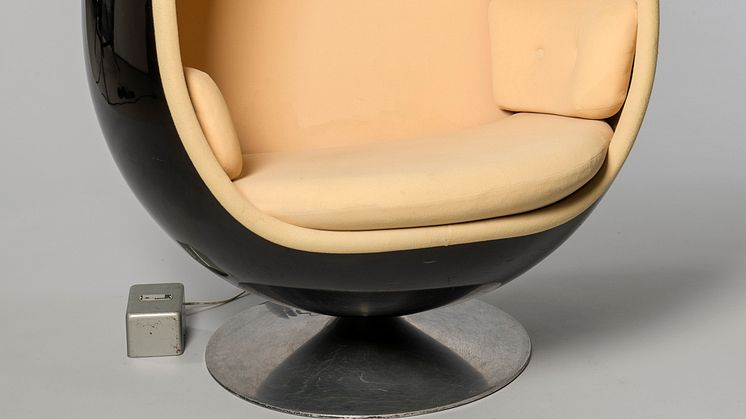
Press release -
New acquisition: Ovalia Egg Chair by Henrik Thor-Larsen
Nationalmuseum has acquired an example of the egg-shaped easy chair Ovalia designed by Henrik Thor-Larsen. The chair was a huge hit when it was launched at the Scandinavian Furniture Fair in 1968. The acquired chair is an early example, dating from the late 1960s.
Nationalmuseum has recently acquired a plastic easy chair by Danish designer Henrik Thor-Larsen (b. 1932), who worked in Sweden. The black egg-shaped chair was launched at the Scandinavian Furniture Fair in 1968 under the name Ovalia and became an instant hit. It was also manufactured in other colours. The chair was made by Torlan in Staffanstorp, Sweden, and sold internationally up until 1978. The design was then revived in 2005. The chair that Nationalmuseum has now acquired is amongst the early examples, having been purchased by leading furniture store Silverbergs in Malmö in the late 1960s. It comprises a black, glass fibre reinforced plastic shell, with an interior upholstered in beige fabric and an aluminium foot. Unusually, the chair has an integral light fitting with transformer – later chairs often had built-in speakers instead. The chair’s design and materials are typical of the forward-looking optimism of the 1960s and can be seen as a Swedish-Danish response to Finnish designer Eero Aarnio’s Ball Chair, which had been launched at the Cologne Furniture Fair two years earlier in 1966.
The acquisition was made possible due to a donation from the Barbro Osher Foundation. Nationalmuseum has no budget of its own for new acquisitions, but relies on gifting and financial support from private funds and foundations to enhance its collections of fine art and craft.
Press contact
Hanna Tottmar, press officer, press@nationalmuseum.se, +46 (0)767-23 46 32
Categories
Nationalmuseum is Sweden’s premier museum of art and design. The collections comprise older paintings, sculpture, drawings and graphic art, and applied art and design up to the present day. The museum building is currently under renovation and scheduled to open again in 2018. In the meantime, the museum will continue its activities through collaborations both in Sweden and abroad as well as temporary exhibitions at the Royal Swedish Academy of Fine Arts, Fredsgatan 12 and Nationalmuseum Design at Kulturhuset Stadsteatern in Stockholm. Nationalmuseum has partnerships with Svenska Dagbladet and the Grand Hôtel Stockholm, and acknowledges the support of FCB Fältman & Malmén.

